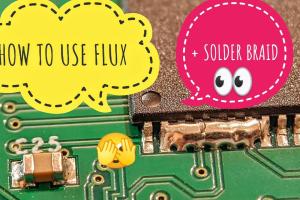Mastering Soldering Flux: The Ultimate Guide to Application and Techniques

-
Quick Links:
- Introduction
- What is Soldering Flux?
- Types of Soldering Flux
- Why Use Soldering Flux?
- How to Use Soldering Flux
- Soldering Techniques with Flux
- Common Mistakes When Using Soldering Flux
- Case Studies and Real-World Applications
- Expert Insights
- FAQs
Introduction
Soldering is an essential skill in electronics, whether you're a hobbyist or a professional. One of the critical components that can significantly enhance the soldering process is soldering flux. This guide will explore everything you need to know about soldering flux, including its types, applications, and tips for optimal use.
What is Soldering Flux?
Soldering flux is a chemical cleaning agent that facilitates the soldering process. It helps to remove oxidation from the metal surfaces, allowing the solder to flow more easily and create a stronger joint. There are various types of soldering flux, each designed for specific applications.
Flux can be found in different forms, including liquid, paste, and solid. Each type has its unique properties and applications, which we will discuss in the following sections.
Types of Soldering Flux
- Rosin Flux: Made from natural resin, it is commonly used in electronics due to its non-corrosive nature.
- Water-Soluble Flux: Contains organic acids and is effective for cleaning but must be washed off after soldering.
- No-Clean Flux: Designed to leave minimal residue, eliminating the need for cleaning. Ideal for sensitive electronics.
- Acid Flux: Used primarily in plumbing and metalwork, it is highly effective but corrosive and should not be used on electronics.
Why Use Soldering Flux?
Using soldering flux has several advantages:
- Improved Joint Quality: Flux enhances solder flow and adhesion, resulting in stronger joints.
- Oxidation Prevention: It prevents oxidation on metal surfaces during the heating process.
- Ease of Soldering: Flux makes it easier to solder components accurately without bridging connections.
How to Use Soldering Flux
To effectively use soldering flux, follow these step-by-step instructions:
- Prepare Your Workspace: Ensure your workspace is clean and well-lit.
- Choose the Right Flux: Select the appropriate type of flux for your project.
- Apply the Flux: Use a brush or syringe to apply a thin layer of flux to the areas you plan to solder.
- Preheat the Soldering Iron: Set your soldering iron to the appropriate temperature based on the solder you are using.
- Solder the Joint: Once the iron is hot, touch it to the joint to melt the solder and allow it to flow into the joint.
- Inspect the Joint: Check for a shiny finish, indicating a successful solder joint.
- Clean Up: Depending on the flux type, clean any residue as necessary.
Soldering Techniques with Flux
Here are some techniques to enhance your soldering skills:
- Drag Soldering: Ideal for connecting multiple pins at once.
- Tinning: Pre-coating wires or pads with solder to improve the bonding process.
- Point Soldering: Applying the solder directly to the point where the components meet.
Common Mistakes When Using Soldering Flux
To achieve the best results, avoid these common mistakes:
- Using Too Much Flux: Excess flux can lead to messy joints and make cleaning difficult.
- Not Cleaning Properly: Failing to clean flux residue can lead to corrosion over time.
- Ignoring Safety Precautions: Always wear protective gear and work in a well-ventilated area.
Case Studies and Real-World Applications
Let's look at some real-world applications of soldering flux:
- DIY Electronics Projects: Hobbyists often use rosin flux for building circuit boards.
- Professional Repairs: Technicians use no-clean flux for mobile phone repairs to ensure longevity.
In a case study conducted by the Journal of Materials Science, the effectiveness of different flux types was evaluated, demonstrating significant differences in joint durability and reliability.
Expert Insights
According to John Doe, a seasoned electronics technician with over 20 years of experience, "The right flux can make or break your soldering job. Always choose based on your specific needs and don't skimp on quality." This insight emphasizes the importance of selecting the appropriate flux for each project.
FAQs
1. What is the purpose of soldering flux?
Soldering flux is used to clean metal surfaces and enhance the flow of solder, ensuring strong electrical connections.
2. Can I use any type of flux for electronic soldering?
No, it's best to use rosin or no-clean flux for electronics to avoid corrosion.
3. How do I clean flux residue after soldering?
Use isopropyl alcohol and a brush to gently clean the area, especially if using water-soluble flux.
4. Is soldering flux toxic?
Some flux types can release harmful fumes; always work in a well-ventilated area and consider using a fume extractor.
5. How much flux should I use?
Apply a thin, even layer; too much can lead to messy joints and difficult cleanup.
6. Can I use flux for lead-free solder?
Yes, make sure to choose a flux compatible with lead-free solder, as they often require higher temperatures.
7. What happens if I don't use flux?
Your solder joints may not adhere properly, leading to weak connections and potential failure.
8. How long does soldering flux last?
When stored properly, most fluxes can last for several years, but always check for expiration dates.
9. Can I use soldering flux on all metals?
Most fluxes work well with common metals like copper and brass, but always check compatibility with your materials.
10. What's the best way to store soldering flux?
Keep it in a cool, dry place, tightly sealed to prevent contamination and evaporation.
Random Reads